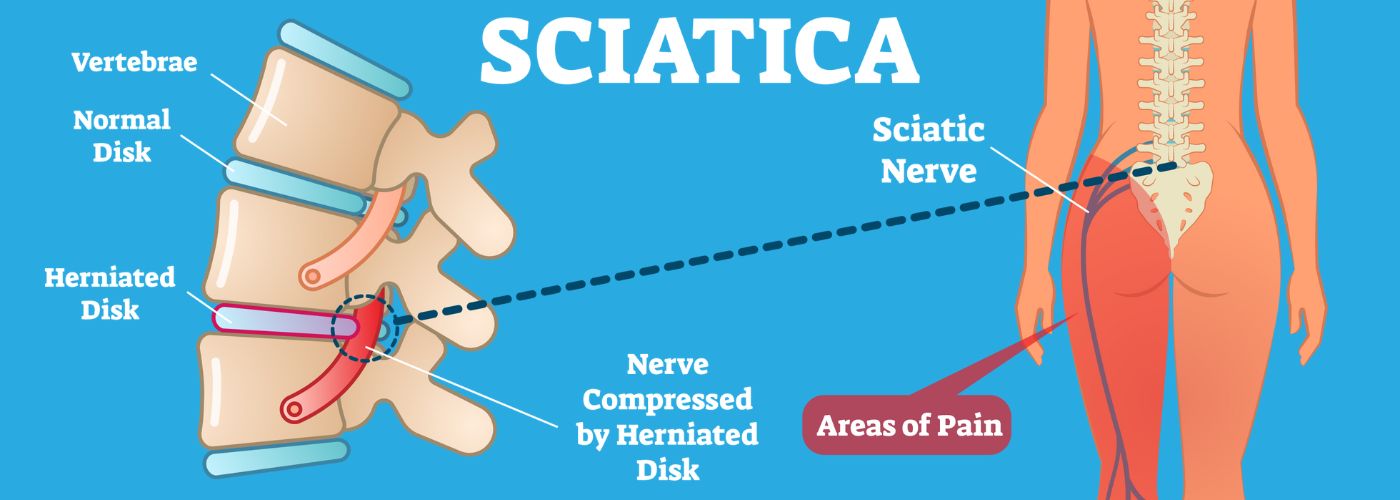Sciatica is a common condition that affects millions of people worldwide. While dealing with sciatic pain can be extremely painful, there are treatments for it besides surgery. We’ll be going over natural treatment options that may help sciatic pain.
What Causes Sciatica Pain?

Sciatica is a medical condition characterized by pain that radiates along the path of the sciatic nerve. This nerve runs from the lower back, through the hips and buttocks, down each leg, and into the feet. The condition usually affects one side of the body and can cause moderate to severe discomfort in affected individuals.
One of the most common causes of sciatica pain is a herniated disc in the lower back. This occurs when one of the discs between your vertebrae slips out of place and pushes against a nearby nerve root. This pressure on the nerve can cause inflammation and irritation, leading to intense pain in the legs and feet.
Another potential cause of sciatica pain is spinal stenosis, which refers to a narrowing of the spinal canal. This reduction in space puts pressure on nerves in your spine, resulting in numbness or tingling sensations in your legs or lower back region.
It can also occur during pregnancy as a result of pressure on the sciatic nerve from an expanding uterus.
Are There Treatments For Sciatica?
One of the most popular treatments for sciatica is TENS & EMS therapy devices.
TENS and EMS are two acronyms frequently used in the field of physical therapy. These therapies provide a non-invasive way to potentially alleviate pain, improve muscle tone, and promote healing. TENS stands for Transcutaneous Electrical Nerve Stimulation, while EMS stands for Electrical Muscle Stimulation.
TENS therapy involves applying electrical impulses to the skin’s surface via adhesive pads placed near the source of pain. These impulses may interfere with pain signals sent to the brain by stimulating the nerves in that area. This stimulation creates a tingling sensation that is thought to help reduce discomfort and increase circulation in targeted areas.
EMS therapy works by sending electrical signals directly into muscles through electrodes attached to the skin’s surface. These impulses trigger muscle contractions, simulating exercise without any actual movement required from patients.
There are tons of TENS & EMS therapy devices available on the market. So, it’s best to choose a therapy device that works with your budget and needs.
TENS & EMS therapy devices are often supplemented with other treatments and should not be the only treatment for sciatica. Always consult with your doctor if dealing with chronic pain related to sciatica.
How Long Does Sciatica Nerve Pain Last?

Generally speaking, mild cases of sciatica nerve pain may last only a few days or weeks, while more severe cases may persist for several months or even years. The key to managing sciatica nerve pain effectively is early diagnosis and treatment. This can help prevent chronic pain and improve overall quality of life.
Common treatments for sciatica nerve pain include physical therapy, medication management, chiropractic care, TENS & EMS therapy, and surgery in some cases.
It is never a good idea to ignore chronic pain like sciatica. Oftentimes, these are underlying health issues that your body may be experiencing. Always speak with your primary care doctor if the pain from sciatica becomes too unbearable.
Does Sciatica Cause Knee Pain?

Sciatica is a common condition that causes pain, numbness and tingling in the leg. While sciatica primarily affects the lower back and legs, some people may experience knee pain as well.
This is because the sciatic nerve branches out into smaller nerves that supply different parts of the leg, including the knee. When these nerves are affected by sciatica, they can cause pain and discomfort in the knee area. However, it’s important to note that not all causes of knee pain stem from sciatica.
If you’re experiencing knee pain along with other symptoms of sciatica, such as lower back pain and leg numbness or tingling, it’s best to see a doctor for an accurate diagnosis.
Can A Chiropractor Help Sciatica Pain?
Chiropractors are trained to diagnose and treat musculoskeletal disorders, including sciatica. They use spinal adjustments, manipulations, and other techniques to restore proper alignment of the spine and improve nerve function.
By targeting the underlying cause of the pain, chiropractic care can help alleviate symptoms of sciatica, such as numbness, tingling, and weakness in the legs.
In addition to spinal adjustments, chiropractors may also use other therapies such as massage therapy, hot/cold therapy, ultrasound therapy or electrical stimulation to further relieve pain associated with sciatica.

Related Stories
Red, White, and Soothe: How HiDow Helps You Recover in the Heat
Recovery that works in winter doesn’t always hold up in the heat. The body reacts...
Jul
Massage Gun Showdown: How the Power Duo Compares to Traditional Methods
Have you ever considered that a handheld device could revolutionize your muscle recovery? With the...
Jun
Fatherly Fitness Tips For Men’s Health Month
Men’s Health Month is more than a date on the calendar—it’s a call to action....
Jun
Built to Move: The Everyday Recovery Edit
Movement is what keeps us going—literally. Whether it’s recovering after a run, loosening up after...
Jun
Unlocking The Secret To Tissue Injury Recovery With TENS/EMS Devices
Have you ever wondered why some injuries take longer to heal than others? Tissue injuries...
May
Get Mobile With HiDow TriggerFlex Tools & TriggerFlex 2.0
Tight muscles holding you back? Whether you’re dealing with daily tension or post-workout soreness, recovery...
May